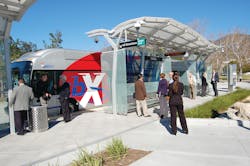CA: Omnitrans Launches BRT Safety Campaign
Passenger service on Omnitrans’ sbX bus rapid transit line is more than three months away, but with 60-foot coaches operating daily beginning in February for system testing and driver training, the agency is launching a safety campaign geared at motorists and pedestrians.
“We are proud to say that in two years of construction on this project — with nearly 400,000 hours worked — we have had zero lost time accidents,” said Omnitrans Interim CEO/General Manager Scott Graham. “Now our focus shifts to keeping motorists, pedestrians, and our bus drivers and passengers safe.”
The 15.7-mile BRT line is the first to be constructed in the Inland Empire and includes nearly 6 miles of dedicated bus-only lanes in the center of the road.
Safety information materials stress three key points:
1. Pay attention to sbX buses on the road daily
2. Stay out of dedicated bus-only lanes
3. Watch for new traffic signs and obey at all times
Newly installed traffic signs include no u-turn, bus-only lane, do not enter and no jaywalking signs. Additionally, yellow curb-like safety barriers are installed to prohibit left turns into bus only lanes. Newspaper ads, social media, posters and community outreach will be employed to help increase awareness of sbX operations and safety features.
Omnitrans hosted a media tour on Jan. 15 to promote the safety campaign and demonstrate features of sbX stations and vehicles. Each of the 23 station platforms feature electronic message signs with real time arrival information, ticket vending machines, surveillance cameras, emergency and customer service phones, public art, seating, shelter and water-wise landscaping.
The 60-foot articulated sbX vehicles run on clean-burning compressed natural gas, have five doors offering level boarding on either side, interior bike racks, wheelchair areas and electrical plug-ins for customer use. Vehicles are equipped with traffic signal priority technology to extend green lights which keep service operating with minimal delays.
